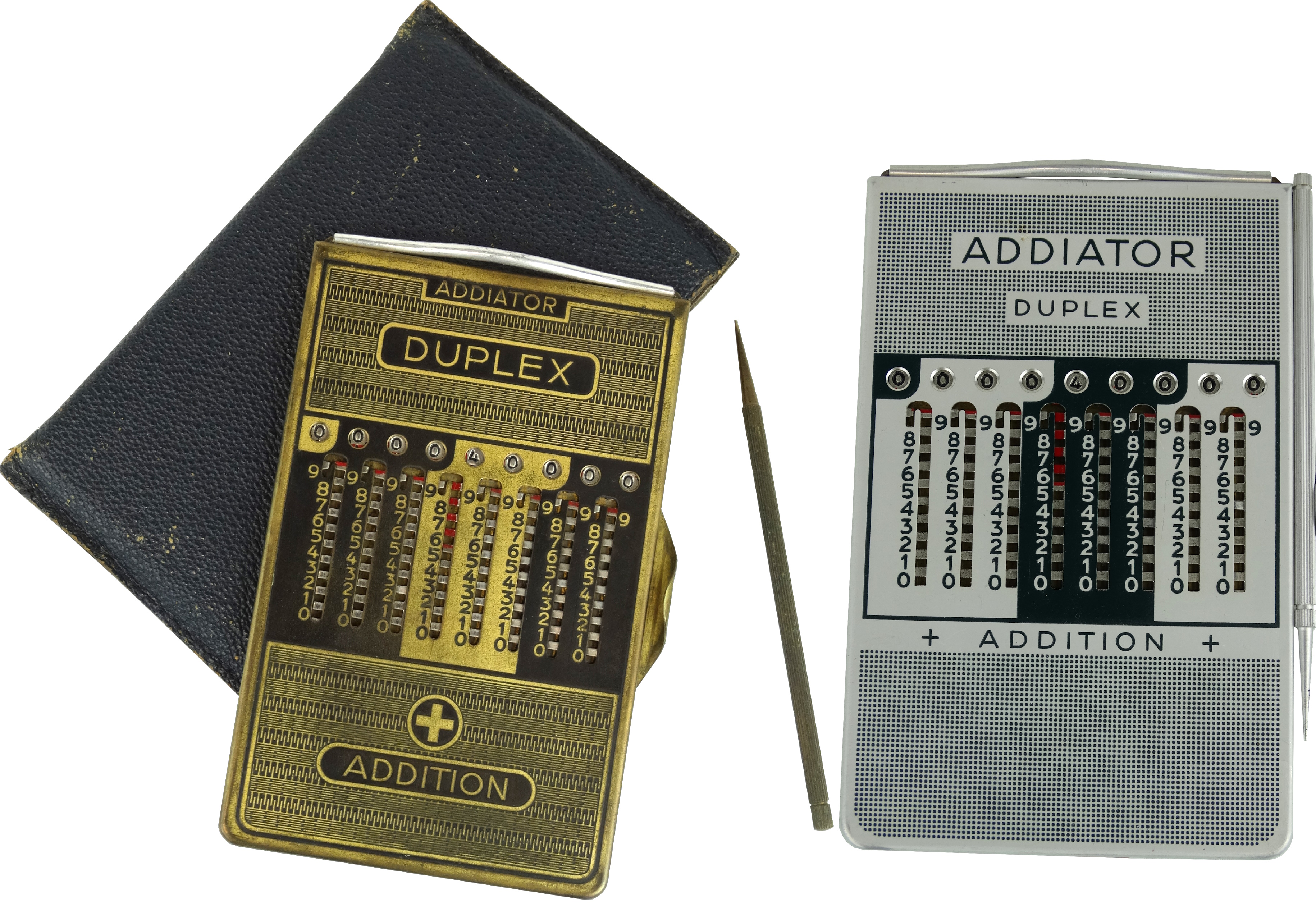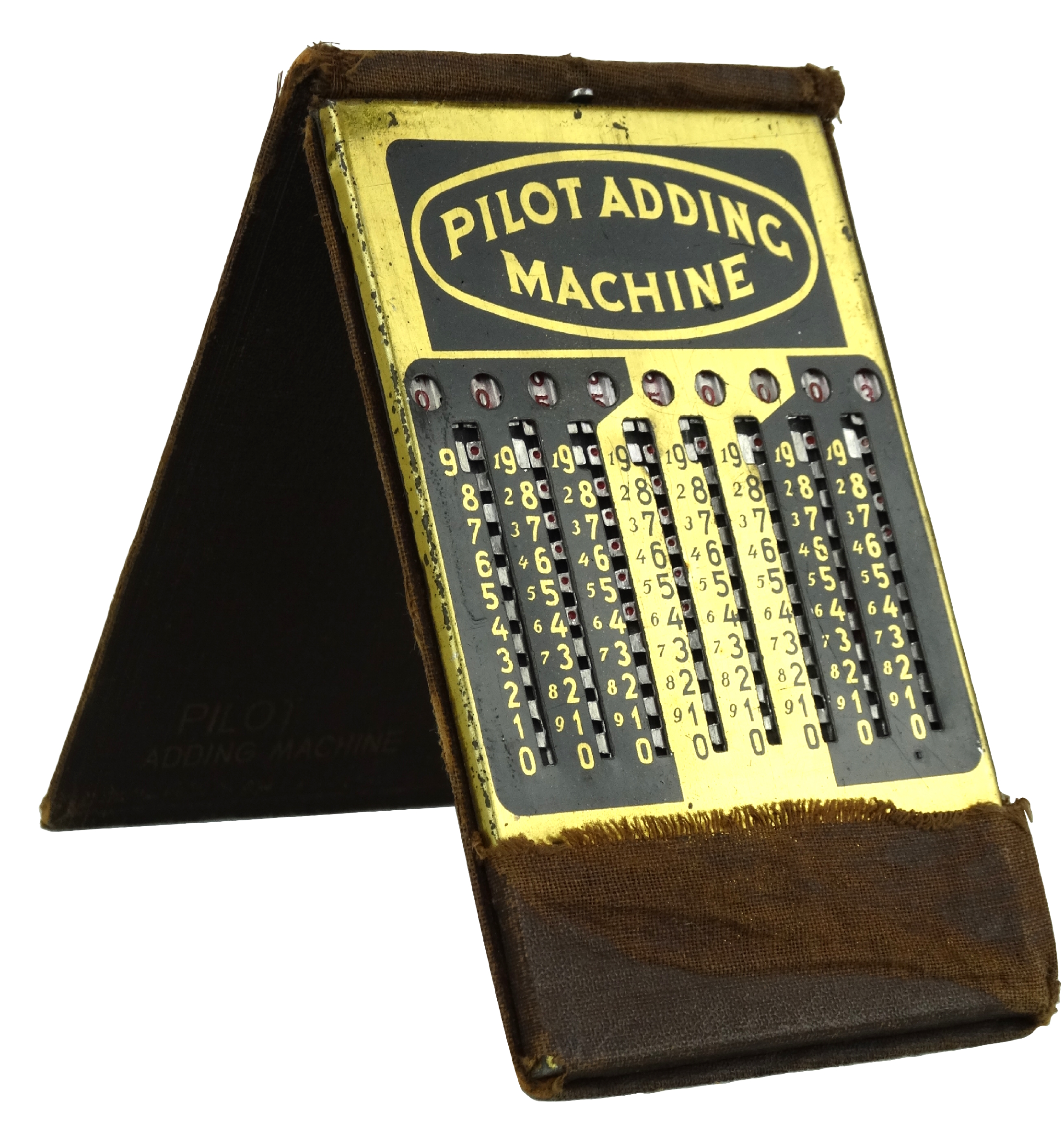For just over three centuries (1669 to 1975), the compact "slide adder" ("rekenschuif", "slide adder", "Zahlenschieber", ...) was a handy tool for tallying numbers. The principle is very simple. A toothed slider is moved over the desired number of positions using a stylus. Each position within a number (units, tens, hundreds, ...) has its own slider. The current value of each position is visible in a cut-out in the case. Whenever the sum of a decimal position is 10 or more, the unit number in that position had to be retained, and the tens number had to be added to the next higher position ("tens' carry"). In the slide adder, this is achieved mechanically by moving the units slider in the opposite direction, and then, by a connection to the next (tens) slider to move it manually by one position. Usually a marker (e.g. a red colour) indicated that a carry was required.
The first version of the slide adder, the Abaque Rhabdologique, was described in 1669 by the Parisian physician and inventor Claude Perrault.
The Frenchman Caze (1720) and the Russian Kummer (1847) built the first commercial slide adders, based on Perrault's principle.
Another name that certainly deserves mention is that of Louis Troncet. His version of the slide adder is called Arithmographe (1889). Slide adders are very often called by the generic name of "Troncet adder" or "Arithmographe"
In Germany, the Addiator brand was very popular, and was often used as a generic name too.
DUPLEX, ADDIATOR (Berlin, Germany), 1930-1975
A slide adder is usually made up of thin metal parts (aluminium, steel, brass, ...), some of which are bent and coated or etched. Fifteen parts are enough for this DUPLEX model. Even the toothed sliders are made from thin sheet metal..

Collection: E. Smet (item 32)
UNIVERSAL, ADDIATOR (Berlin/Wolfach, Germany), 1930-196x
This slide adder has an extra register at the bottom, so that if you subtract a larger number from a smaller one, you get the negative sum.

Collection: E. Smet (item 50)
ADD-A-TIME, ADDIATOR (Wolfach, West-Germany), 1957-1967
This slide adder is suitable for quickly adding hours (decimals) and minutes (on the front) or subtracting them (on the back). The manual supplied with this machine is that of the Astro-ADDIATOR, which had two extra columns for seconds. It can of course also be used to calculate angles (degrees, minutes and seconds). This slide adder was sold to astronomers and pilots. It was also used at the famous Berlin AVUS race track. This slide adder has not been removed from its original plastic packaging.

Collection: E. Smet (item 53)
DUPLEX, ADDIATOR (Berlin or Wolfach, Germany), 1930-1975
This “medium model” was more compact than Addiator's "standard model". The black/gold model is made of brass, the silver/green one of aluminium.

Collection: E. Smet (item 9 and 113)
STANDARD, ADDIATOR (Berlin or Wolfach, Germany), 1933-196X
Handy for the desk, and still compact to store.

Collection: E. Smet (item 57)
ADDIMAX HEXADAT, ADDIATOR (Wolfach, West-Germany), 1967-197x
Adding and subtracting hexadecimal numbers became much easier for programmers with the help of this slide adder. The upper field additionally shows the complement of the lower field. Addiator had a "programmer's kit" which included a HEXADAT, a decimal slide adder and a slide rule. There was also an OCTADAT for octal numbers.

Collection: E. Smet (item 95)
Pro Calculo!, CBR or BUG (Berlin, Germany), 1921-1923
Otto Meuter developed this model when he was still collaborating with Carl Kübler, the owner of the firm Addiator-Gesellschaft. Animosity between the two men made Meuter set up shop with Jean Bergmann, owner of “Continentale Büro-Reform” (CBR) and the “Bergmann Universal Gesellschaft” (BUG).

Collection: E. Smet (item 261)
PILOT ADDING MACHINE, CBR for Z.ZIEMBICKI (Berlin, Germany), ca. 1921
Just like the Pro Calculo!, this slide adder allows you to add and subtract. Zeroing is done by pulling out the top slider completely and pushing it back in.


Collection: E. Smet (item 156 and 207)
The Pocket Adding Machine, CBR (Berlin, Germany), 1921-1925
The British pound sterling (£) was divided into 20 shillings (Latin: solidus, symbool s) and a shilling consisted of 12 pence (singular: penny, represented by the symbol d, from the Latin denarius), until the decimal system was introduced in 1971. Cute is also the faux-snake leather etui in cardboard.

Collection: E. Smet (item 358)
CORRENTATOR, CBR (Berlin, Germany), 1924-193x
This slide adder has a hinged cover so that you can easily switch from adding to subtracting and vice versa. This makes it possible to carry tens only at the top (adding) or at the bottom (subtracting).

Collection: E. Smet (item 338)
CORRENTATOR, CBR (Berlin, Germany), 1924-193x
A cast iron weight is added to the bakelite stand to make it heavier. The knob to flip over the cover is sadly missing in this example (on the right, at the location of the hinge).

Collection: E. Smet (item 93)
CORRENTATOR-UNICAL, Unical (Basel, Switzerland), ca. 1945
From 1945 on, the Correntator was no longer manufactured in Germany, but in Switzerland.

Collection: E. Smet (item 258)
TASCO ARITHMOMETER, Morse Chain Company (New York, U.S.A.), ca. 1945
This gleaming "pocket" calculating aid is also praised in the manual as “The best computer made” and as suitable for "all four main operations". To switch from addition to subtraction, the mask is shifted up. It was distributed by the Tavella Sales Co. on West Broadway in New York. The packaging and manual refer to the quasi identical GRAY slide adder.

Collection: E. Smet (item 158)
POCKET Calculator, MBC (Japan), ca. 1950
This slide adder can be used for both addition and subtraction. Adding with tens' carry in a particular column is done at the top (silver arrow and + sign), 'borrowing' from the column on the left on subtraction is done using the carry at the bottom (red arrow and - sign).

Collection: E. Smet (item 137)
MACHINE À CALCULER, ReBo (Marseille, France), ca. 1920
The French engineer Reybaud patented this calculating aid in 1923. This version, with its pretty Art Nouveau decoration, was sold with a "bloc chimique pertétuel" (known in Germany as a "Zaubertafel"). It could be used to write down intermediate results.

Collection: E. Smet (item 82)